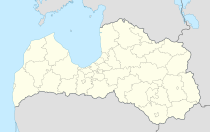Saulkrasti
| Saulkrasti | ||
|---|---|---|
 |
|
|
| Basic data | ||
| State : |
|
|
| Landscape: | Livonia ( Latvian : Vidzeme ) | |
| Administrative district : | Saulkrastu novads | |
| Coordinates : | 57 ° 16 ' N , 24 ° 25' E | |
| Residents : | 3,280 (Jan 1, 2016) | |
| Area : | 4.8 km² | |
| Population density : | 683 inhabitants per km² | |
| Height : | ||
| City law: | since 1991 | |
| Website: | www.saulkrasti.lv | |
| Post Code: | ||
| ISO code: | LV-089 | |
Saulkrasti (literally: 'sunny coast', German Neubad ) is a small town on the coast of the Bay of Riga in Latvia . In 2016 it had 3280 inhabitants.
Geographical location
Saulkrasti is located north-northeast of Riga and stretches about 17 km along the Via Baltica (European route 67) on the bank of the Riga Bay . The place begins in the south on the river Incupe ( Latvian : Inčupe ), is crossed by the rivers Peterupe (Latvian: Pēterupe ) and Kisupe (Latvian: Ķīšupe ) and ends in the north behind the Adje river (Latvian: Aģe ).
City structure
Saulkrasti covers the area of the 5 originally independent localities
- Seaside resort (Latvian: Bādciems )
- Katharinenbad (Latvian: Katrīnbāde (today: Pabaži) )
- St. Peters Chapel (Latvian: Pēterupe )
- Neubad (Latvian: Neibāde )
- Fishing village (Latvian: Zvejniekciems )
City arms
The Saulkrasti coat of arms symbolizes the sun in the sky above with a golden semicircle on blue and below with a representation split from green to silver, the 4 rivers (silver) and the 5 districts (green).
see also: Blazon
history
- 1823 was created as a seaside resort of the manor Koltzen named after this characteristic place resort .
- Saulkrasti was formed in 1933 as an administrative unit from the towns of Badeort, Neubad and Peterbach.
- In 1935 , the Riga - Rūjiena railway line was expanded with four stops in the area of today's city of Saulkrasti (Pabaži, Saulkrasti, Ķīšupe and Zvejniekciems).
- 1950 Pabaži (formerly Katharinenbad) was incorporated. The name "Katharinenbad" was chosen after the Russian Tsarina Catherine the Great ( Catherine II ), who was crowned in 1762 . In 1764 she drove through this place, coming from Saint Petersburg , to take a bath and to take part in the "Lindenfest" (in honor of the tree that was still widespread in the Baltic dune landscapes at that time).
- In 1967 the fishing village was incorporated.
- In 1991 Saulkrasti received city status.
The name “Saulkrasti” is made up of the Latvian word for sun ( saule ) and the Latvian word for bank ( krasts ) - meaning “sunny bank” or “sunny beach”.
Saulkrastu novads
In the course of an administrative reform in 2009, the city (with 3280 inhabitants) was combined with its rural community (with 2885 inhabitants) to form a district (let. Novads). On July 1, 2014, a total of 6165 residents lived here.
Town twinning
Saulkrasti has a town partnership with the Swedish municipality of Gnesta .
literature
- Hans Feldmann , Heinz von zur Mühlen (ed.): Baltic historical local dictionary, part 2: Latvia (southern Livonia and Courland). Böhlau, Cologne 1990, ISBN 3-412-06889-6 , p. 413.
- Astrīda Iltnere (ed.): Latvijas Pagasti, Enciklopēdija. Preses Nams, Riga 2002, ISBN 9984-00-436-8 .
Individual evidence
- ↑ «Latvijas iedzīvotāju skaits pašvaldībās pagastu dalījumā"
- ↑ Hans Feldmann, Heinz von zur Mühlen (ed.): Baltic historical local dictionary, part 2: Latvia (southern Livland and Courland). Böhlau, Cologne 1990, p. 413.

